#construction document
Explore tagged Tumblr posts
Text
Construction Document Management Software: A Deep Dive for Modern Projects
Construction projects generate a mountain of documentation – plans, specifications, change orders, RFIs, submittals, and more. Managing this effectively is crucial for project success. Construction document management software (CDMS) has emerged as a vital tool to streamline this complex process, improving collaboration, reducing errors, and saving time and money.

The Challenges of Traditional Document Management
Before we explore the solutions, let us understand the problems CDMS is designed to solve:
Version Control Nightmares: Multiple revisions and updates make it difficult to ensure everyone is working with the latest documents.
Data Silos: Information gets trapped in emails, shared drives, or even physical filing cabinets, hindering collaboration.
Search and Retrieval: Finding specific documents can be like searching for a needle in a haystack.
Communication Breakdowns: Lack of clear communication channels leads to delays and misunderstandings.
Risk of Errors: Manual data entry and misfiled documents increase the potential for costly mistakes.
The Benefits of Embracing Construction Document Management Software
CDMS addresses these pain points and delivers significant advantages:
Centralized Repository: All project documents are stored in a single, accessible location.
Version Control: Every change is tracked, ensuring everyone has access to the latest versions.
Improved Collaboration: Team members can easily share, review, and mark up documents.
Streamlined Communication: RFIs, submittals, and other communications are managed within the system.
Efficient Search: Powerful search functions make finding documents quick and easy.
Reduced Errors: Automated processes minimize manual data entry and the risk of mistakes.
Increased Transparency: Project stakeholders have real-time visibility into project progress.
Cost Savings: Streamlined workflows and reduced errors lead to significant cost savings.
Compliance: CDMS helps ensure compliance with industry regulations and standards.
Top 11 Construction Document Management Software
1. Procore: This all-in-one construction management platform offers extensive document management features, including unlimited storage, linking related documents, custom templates, and granular permissions management. Its mobile app facilitates document review and approval on the go.
2. Autodesk Construction Cloud (BIM 360): This cloud-based platform shines in BIM integration, allowing seamless collaboration between design and construction teams. Its document management module includes version control, markups, and issue tracking.
3. iFieldSmart Technologies: This end-to-end construction management platform includes a robust construction drawing management module with features such as version control, cloud-based storage, granular permissions, RFI linking, and mobile access. It enables real-time collaboration between field teams, subcontractors, and project owners.
4. PlanGrid (now part of Autodesk): Known for its user-friendly interface and mobile-first approach, PlanGrid simplifies document sharing, versioning, and hyperlinking. It's ideal for teams who need to access documents on construction sites.
5. e-Builder: Geared towards enterprise-level construction program management, e-Builder offers a robust document control module with workflows, approvals, and transmittals. It integrates with other e-Builder modules for comprehensive project management.
6. Aconex: This platform excels at managing complex, large-scale infrastructure projects. It offers comprehensive document management, including transmittals, workflows, and controlled access. It also features tools for managing tenders and contracts.
7. Trimble Connect: Trimble Connect covers the entire project lifecycle, from design to handover. Its document management capabilities include version control, clash detection (for BIM models), and mobile access for field teams.
8. Newforma Project Center: This platform specializes in project information management, centralizing emails, documents, and other project data. It offers powerful search capabilities, automated filing, and reporting features.
9. Buildertrend: Designed for homebuilders and remodelers, Buildertrend includes document management as part of its wider suite of tools. It allows for easy document sharing with clients, subcontractors, and team members.
10. Viewpoint Vista: This comprehensive construction ERP solution includes integrated document management, along with features for accounting, project management, and field operations. It's suitable for construction companies seeking a unified platform.
11. Bluebeam Revu: While not a full CDMS, this PDF markup and collaboration tool integrates seamlessly with many CDMS platforms. It allows for detailed annotations, measurements, and comparisons of document versions.
The Future of Construction Document Management: AI and ML :
Artificial intelligence (AI) and machine learning (ML) are poised to revolutionize construction document management. Here's how:
Automated Data Extraction: AI can extract relevant data from documents, reducing manual entry.
Intelligent Search: ML algorithms can improve search results by understanding the context of documents.
Predictive Analytics: AI can analyze project data to predict potential risks and issues.
Document Classification: ML can automatically categorize documents, making them easier to find.
Smart Automation: AI can automate repetitive tasks, freeing up valuable time for project teams.
Top 10 FAQs on Construction Document Management Software :
1. Is cloud-based CDMS secure?
Reputable providers use robust security measures to protect data.
2. Can CDMS integrate with other construction software?
Most CDMS platforms offer integration with other tools.
3. How much does CDMS cost?
Pricing varies depending on the provider and the features you need.
4. Is CDMS difficult to implement?
Many providers offer training and support to help with implementation.
5. What is the ROI of CDMS?
CDMS can deliver significant ROI through improved efficiency and reduced errors.
6. Is CDMS only for large projects?
No, CDMS can benefit projects of all sizes.
7. Can CDMS be used for other types of documents?
Yes, CDMS can be used for any type of project-related document.
8. Does CDMS replace the need for paper documents?
While some documents may still need to be printed, CDMS significantly reduces paper usage.
9. Can I try CDMS before I buy it?
Many providers offer free trials or demos.
10. What is the future of CDMS?
The future of CDMS lies in AI and ML, which will further enhance its capabilities.
Conclusion
Construction document management software is no longer a luxury; it's a necessity for modern projects. By embracing CDMS, construction companies can improve collaboration, streamline workflows, reduce errors, and deliver projects more successfully.
Visit: www.ifieldsmart.com/construction-document-management-software
#Construction document management software#Construction document management#Construction document#Construction#civil#civil engineering#architect#builder
0 notes
Text
The Role of Virtual Design and Construction in Modern Architecture

The role of virtual design and construction in modern architecture. Explore how VDC is shaping the future of architectural practices. VDC, or Virtual Design and Construction, is a game changer in the architecture field due to the fact that it has revolutionized completely how buildings are conceived, designed, and constructed. With the integration of advanced digital technologies such as 3D modeling, Building Information Modeling (BIM), and collaborative programs, VDC has now become an unavoidable tool for architects, engineers, and contractors.
0 notes
Text
Core Gems
So when a ghost becomes injured, they have a last ditch defense where they retreat into their core. And I mean, injured badly where their body is rip apart to the point they can’t hold a solid form anymore. And they basically go into a hibernation state until they are strong enough to form again.
Ellie, Danny, and Dan are all injured in a final battle against the GIW. The organization was destroyed and the ghosts were safe but the halfas ended up being so injured that they reverted to core form and then went to sleep for a bit. When they woke up, they were still weak but at least recovered enough to gain consciousness. And realize…they are in some kind of auction…in the middle of a heist. It appeared that two furries (one in a bat costume and one in a cat costume) were ducking it out. And they…they were a necklace. All three of them had been turned into a necklace with their cores as gems accompanied by sapphires, pearls, and opals. And frankly gorgeous craftsmanship as the metal was crafted around their cores as if to cradle them and the other gems.

Unfortunately, they were too weak to take a form properly, they could still feel the strain on their bodies. But at least they could still communicate through their auras. Then the cat lady punched a hole in the glass container surrounding them and grabbed their necklace.
However, the bat grabbed the other end and it resulted in a sort of tug-a-war. Meanwhile, Danny, Ellie, and Dan were having a back and form commentary on the situation and what they should do. Completely unheard by the other party.
In the corner of their eye, the three halfas finally noticed a third contender. Some kind of clown who was…hold on…holding a gun?! And it was pointed straight at the two fighting furies who had yet to notice him. The ghosts’ protective instincts went into overdrive and they frantically tried to shout, yell, move. Just do something to warn the two but their cries fell on deaf ears. All they succeeded in doing was faintly glow which immediatly caught the attention of the fighting duo. The two turned to look at the strange necklace but right at that moment, the clown fired and a gunshot rang throughout the auction room. Having no other options, Danny and the others poured every ounce of ectoplasm they had to try and phaseshift, making the two furries intangible as the bullets passed right through them, but in their shock, the two jumped away in opposite directions and accidentally ripped the necklace apart. Gems and pearls went flying and the three cores bounced along the ground.
Luckily, the two finally noticed the clown and went to deal with him and his minions who had appeared. Seemingly putting their fight on hold and forming a temporary truce. The three halfas could only watch as the battle finally wound down, ending with the cops barging into the place and arresting the clown and his grunts, the cat managing to escape with half the scattered gems and pearls from the broken necklace along with a few other jewelry pieces (none of their cores though) and the bat leaving through a skylight.
The auction continued and in the end, despite being broken, their necklace seemed to have caught someone’s interest. A man named Bruce Wayne bought up every piece of the shattered jewelry wear. The auctioneers appeared relived that the item managed to sell in the end and gratefully gave it to him.
Bruce had no idea what happened at the auction, but he could have sworn that some of the gems faintly glowed right before he and Selina were shot. If the necklace was some sort of magical item, then he needed to understand exactly what has been brought to Gotham. It was unfortunate that Selena had taken some parts of the necklace but he utilized his vast wealth to make sure all the other parts ended in his possession. Now he would take them back to the mansion for examination.
#Dpxdc#dcxdp#kizzer55555 ideas#Bruce thinks the necklace is magical. He’s technically not wrong.#When he gets home he immediately puts each gem in a glass container to examine them. For the longest time though nothing happens.#They all look like normal gems except for the main three of the piece. He can’t identify what kind of gem they are.#The gems are perfect spheres with various shades of blue (with hints of green and white) swirling around.#The colors almost look like they are moving in slow motion. Still. Nothing happens as he examines them and no strange events happen.#That is until one day he decided to take the gems to be examined by a professional and a villain attacked.#A piece of building was about to crush him when a wall of ice appeared as a shield over him. After that he took them back to the cave.#Bruce looks up thousands of documents about enchanted necklaces and artifacts but finds nothing. He even calls in favors from JLD.#Zatanna doesn’t recognize them but feels some kind of power coming off the gems however it doesn’t feel malevolent (at least for 2 of them)#(The last gem is neutral.) Also Constantine was unavailable (*cough* hiding from responsibilities *cough*)#The other bats get interested in the gems. Tim has a theory that they are some kind of protective charms. Damian agrees.#(Everyone is shocked Tim and Damian agree on something). So while Bruce is continuing his investigation the other bats decide to do some#‘Field testing’ and take the gems out. Consequently the gems end up saving their lives and they discover a few things they can do like make#The wearer invisible. Intangible. Create green barriers/constructs. Create ice. Vibrate when an enemy is coming. And much more.#The bats fashion them into new individual bracelets/necklaces and think they are the coolest thing. They have powered up protective charms!#The halfas just wish these kids would STOP PUTTING THEIR LIVES IN DANGER! What are they MORONS?!#Most of the ectoplasms they recover is used to protect the bats and nearby civilians.#(Dan also trolls people and is mostly protective his siblings though)#People notice the new power ups. A rougue gets his hands on a gem and tries to use it ONCE to attack something but the gems didn’t respond.#Then it froze the rough’s legs to the ground.#Much time later the gems are swapped between the bats and alternated and have just become a new item in their belt#(batman was not pleased but eventually got used to it and begrudgingly accepted that they were useful. Especially when they save his kids)#They come to a Justice league meeting and Constantine finally sees them.#His mouth drops in shock and he frantically asks where they got GHOST CORES?! And this is when the bats finally realise what they have.#And are horrified to realize EXACTLY what they are holding and that these ‘gems’ were technically ALIVE.#Meanwhile the three Halfas have been kinda chilling but also working their butts off to keep this family alive. It was a fulltime job.
993 notes
·
View notes
Text


Quick and easy bum pad for my edwardian outfit in progress, made from scraps
#talkies#documenting the birthday outfit construction#bought a shirt pattern. found every other pattern on archive except for skirt which i found pattern for but... might buy
37 notes
·
View notes
Text
While we're in the prep phase for the Crusader...
...let's go through the Ideas Archive, explore the stuff that's shelved, canned or otherwise not happening right now. This'll be the new pinned post, so I'll use this as a place to put everything I'm currently working on, and what I might do at some point.
Current:
The Crusader, a mix of Burns Double Six, PRS CE24 and Rickenbacker 4001, combined with influences from Hamer, Gibson and Fender. Note: this build is currently in the wood prep phase (stripping pieces of mahogany and sapele door for use in the guitar body and neck) as of 21/11/2024, and will likely take a year at my current progression rate.
Shelved:
Fender Marauder Build (yes, I still want to do this. The Crusader evolved from this, so it's still on the cards)
Casino Humbucker Mod
G6122 Country Gentleman '62 Style
Crest Replica (NEW!)
Telecaster Bass VI (kit body, custom neck)
Lennon Les Paul Jr. Replica (kitbash)
Höfner Violin Bass from scratch
Canned:
Lerxst 355 Replica
Acoustic Rickenbacker 360/12C63
Telecaster-Shaped Red Special (TSRS)
Plausible:
A non-specific doubleneck.
Resonator acoustic (kit build)
Completed:
Fretless Stratocaster
Cherry XII/Tele-Shaped Rickenbacker (TSR)
So, let's review top to bottom.
The Crusader:
I don't need to explain this much, I've already made a long-ass post about this. As said above, it's a mix of a Burns Double Six, PRS CE24 and Rickenbacker 4001 combined with influences from Hamer, Gibson and Fender.
The design is set in stone, aside from the exaggeration of the upper horn. You'd understand if there was a picture around here of the Burns. In the meantime, I'll get on with describing the others.
Fender Marauder Build:
Not the wackiest idea here, not by a long shot. As previously described, the Marauder is the culmination of Fender's offset guitars, featuring the switching of a Jaguar, the lead-rhythm circuit of a Jazzmaster, parts of the trem system of a Mustang, modified to fit with the pickguard and general aesthetics of a Jag. It even gave the Starcaster, the only semi-hollow by my reckoning that Fender still produces, it's headstock, something Fender afficionados call the "running shoe", at least, that's what my aunt calls it. Considering the contour gets filled in by paint, it's not hard to see her point.
The issue with doing this one is that barely anyone does Marauder vibrato plates. And to do this from scratch? Yeah, I need to find someone who would do the specific metal pieces I'd need, that being the Jag-style metal plate for the lead-rhythm circuit, the switch plate for the pickup switches, the extra long control plate, and that Marauder vibrato plate.
Yeah, if I ever find somewhere that does metal parts out of aluminium or something, I'm gonna get them to do the metal parts of this. Next item on the list!
Casino Humbucker Mod:
This one should be self-explanatory - take an Epiphone Casino, stick some P90-sized humbuckers in there. The only caveat is that they have to be hidden and mounted via dogear P90 covers, which isn't too much of an ask; this guy in Manchester does custom pickups, even hand-winds them. Certainly sounds appealing, may go for those. Next one!
G6122 Country Gentleman:
Yeah, uh... this one's shelved with good reason.
For context, the G6122, more commonly known as the Country Gentleman, is one of Gretsch's most famous guitar models, up there with the Duo-Jet, the Tennessean (now Tennessee Rose) and the one that Malcolm Young gutted and modded for his purposes as the rhythm guitarist of AC/DC. Gretsch list it as the "Jet" but I have no clue if that's a different model to the Duo-Jet or it's a variation, or whatever.
My aim with this would be to make as accurate a recreation of the Country Gent as I could with the documentation and information present on the internet. That means making it with 3-ply maple veneer top, back and sides, utilisng the thumbnail inlays on an ebony fingerboard, slotted for 24.6" (24.75" if you measure from the middle of the nut), with the same style of tuner, the little plaque on the headstock, the vinyl/leather pad on the back of the body covering a backplate access hatch, and all around trying to recreate this mad thing.
The only downside is the cost, because I'd need to source TV Jones Filter'Trons (not hard), maple veneer (harder), Grover Imperials or lookalikes (very hard!), and figure out how to make a veneer press, and how to shape the slightly arched top and back in a 3-ply veneer, not to mention the Bigsby, all the spare parts, the flip-up foam mutes that Jimmie Webster came up with (and also patented).
In short, the entire project is shelved. For the foreseeable future, until I can source all this stuff myself. Onto the next one!
Crest Replica:
This is a new one, inspired by an admittedly newfound appreciation for the Gibson Crest.
...oh right, I should explain what that is.
The Gibson Crest, as a name, refers to 2 different models, respectively produced around the late 1950s to early 1960s and between 1969 and 1972, with a one-off model of the latter style produced in 1983 for that year's Winter NAMM show. Said model is in the possession of guitar collector and YouTuber Trogly, who runs the eponymous Trogly's Guitar Show on YouTube. At first, I thought he was a bit of a knob, or at least a bit naïve, but as it turns out, his show's a good way to pass the time, and satiates the GAS (gear acquisition syndrome) that guitarists seem to get pretty damn often (as far as I know).
The former is estimated to have been produced a total of no more than six times, each custom orders put in by Gibson salesman-clinician and budding guitarist, Andy Nelson. Due to the nature of being entirely custom orders, no one knows the exact specs as they would obviously vary between examples as each guitarist would want something unique.
The body shape is assumed to be reminiscent of a similar model that Gibson were producing around this time: the L-5CT, that being a jazz archtop around the thickness of a Gibson Byrdland, but with a Venetian cutaway, a singular humbucker, a toggle switch next to the cutaway on "deluxe" models (models with 2 pickups as stock) and a trapeze tailpiece paired with a "floating" or freely moveable bridge.
One example of the original Crest, however, had a thinline single-cutaway body with a Florentine cutaway, as opposed to the Venetian cutaway of the L-5CT. It featured a carved spruce top, maple back and sides, with a 7-ply bound top, and a 3-ply bound back, as well as a pickguard made not of plastic, but of alternating dark and light plies of maple.
Now, that's interesting, because (and this is a personal side tangent because this guitar is so very unknown because of Google's overuse of SEO and keywords) the only other guitar Gibson produced with a wooden pickguard that I can think of is the Gibson The Les Paul, produced between 1976 and 1980, and that was only because the way Norlin-era Gison constructed these things, everything was either wooden or metal, with plastic being used as little and as sparingly as possible. The switch tip was rosewood, the binding for the body was rosewood, the veneer on the headstock was rosewood as opposed to holly, the knobs were rosewood, the pickup rings were rosewood. About the only thing I can find that wasn't wooden or metal is the inlays, which are actual abalone, and the binding for the headstock, which appears to be plastic, though this might not be the case.
Point is, the guitar was designed with one main principle in mind: "Can it be rosewood? Yes? Make it rosewood." That's why they now go for around £35k and rarely ever sell.
But anyway back to the Nelson Crest. Yes, that's what I'm calling it, it's better than calling it Crest 1 or Crest Custom. The example I'm drawing from here had bound f-holes, was stained cherry red like most of the ES models around the time, and had an HS pickup layout, with the usual number of volume and tone controls, and a toggle switch in the usual mounting place for an ES model guitar, that being near the treble-side f-hole.
According to the source I'm getting all this from (an article on the Gruhn's Guitars website), it also had a Switchmaster tone switch and was wired for stereo output. The floating bridge, as it was an archtop, was mounted on a rosewood "foot" which was inlaid with mother-of-pearl decorations. The bridge itself, meanwhile, was your bog standard late '50s, early '60s Gibson ABR-1 without retaining wire for the saddles, while the tailpiece has the diamond ornamentation seen on a Casino/ES-330 while also incorporating a shield and coat-of-arms motif.
This motif is continued on the absolutely gigantic headstock, which had individual Grover Imperial tuners, and an inlay featuring a coat of arms with three Moorish crescents on the shield. The fretboard is given the top-level treatment of the era, as is to be expected of a custom build, with 3-ply binding all-around, and Super 400 inlays up to the 17th fret, unsurprising for an archtop. The truss rod cover, meanwhile, is a sort of merger between the typical shape for a Gibson, and the art deco movement which was starting up in the early '60s, with it being a trapezoid interpretation of the standard Gibson bell shape.
This is one of the few images I can find of the original style of Crest, in all its resplendent late 1950s glory:
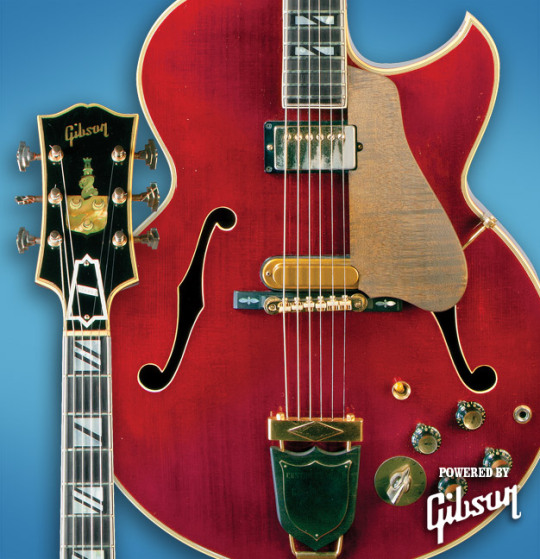
As you can see, it's basically everything I mentioned above, down to the cherry red stain.
So, that's the Nelson Crest, in all of its custom and stupidly insane glory. It'd be an interesting challenge to replicate that thing, but that's not the one I want to replicate, not by a long shot.
The Crest that I do want to replicate, however, is more reminiscent of a short-neck ES-330 or, to be more conforming to normality here, the Epiphone Casino. This has its own subsets, referred to as Crest Gold or Crest Silver, for the style of the hardware, those being either gold or "brushed silver". Assuming I was mad enough to build this, I would have to either source vintage-accurate parts or get someone to make them custom.
As you can probably guess, neither sound appealing! However, ignoring that, let's get down to business. What is the Gibson Crest, in this latter format?
The Gibson Crest, in the 1969-72 styling, is a double-cutaway ES-style guitar, as you can probably guess. Now, a double-cut ES-style isn't surprising, both CMI and Norlin loved making those. The surprise comes from the features, starting with the short neck, with the join at the 15th fret. Now, normally, that's weird for an ES-style, they all have long necks, with a meeting with the body at the 19th fret. Why does this one have such a short neck?
Well, it's because it's a hollow-bodied guitar, like the ES-330 or Casino. Then again, that is no excuse, considering the ES-330 and Casino both had long necks at this time, even if the Casino returned to the short neck, dragging the 330 along with it whether it liked it or not (kinda miffed about that, I like upper fret access, taking it away on an electric guitar like the Casino is just annoying).
But anyway, the Crest has this short neck, and that's where the similarities to most ES models end. The toggle switch is placed where the first iteration of the 347 would place the coil-split switch, that being the lower horn, and that's about it for known similarities, with the other features being more reminiscent of the original Nelson Crest rather than an ES-330 or similar guitar from Gibson/Norlin.
Let's start with the pickups, which are mini-humbuckers, most certainly an interesting choice; apparently, the reason they chose P90s as the pickups for the 330 and Casino is because it was a "budget" model, and not because they were fucking cowards. That last bit's not important, though, so we can come back to it at a different time.
As with the Nelson Crest, the Crest Gold and Silver have a floating bridge akin to an archtop, though I cannot for the life of me remember if they're an ABR-1 like the original, or a pre-compensated bridge. It doesn't much matter either way, because the fact of the matter is that this guitar has some nice details to it. A 7-ply bound top, with a 3-ply bound back separated by a decorative strip, and a large heel cap which has a strap button screwed into it.
The electronics are the interesting thing. As noted above, the toggle switch was placed in the location where an ES-347's coil-split switch went, which may even be where they got the idea for that, but as is also noted above, the thing has 2 mini-humbuckers with individual volume and tone controls, and treble-side adjustment screws that go through the pickguard.
None of this is nearly as impactful as what the thing was made of, though, because I have been keeping that bit entirely shtum for surprise factor. Y'see, the Crest was made almost exclusively out of Brazilian rosewood veneer, which, for a time, was entirely phased out of Gibson as a wood option, before even becoming a protected wood by the Washington Convention. Trade in it is restricted, even now, and that means it is incredibly hard to get hold of it, even in veneer form.
Does this mean I am shit out of luck? Well, if I wanted to recreate the thing using the exact same wood, yes. If, however, I wanted to recreate the guitar with just any species in the family Dalbergia, rather than specifically Dalbergia nigra (note: that's the scientific name for Brazilian rosewood), I am not, in fact, shit out of luck, as most other species of rosewood (any wood in the family Dalbergia) is not restricted, and has not been under restriction for almost 5 years.
Here's a photo from Gary's Classic Guitars in case you were having difficulty visualising this thing:
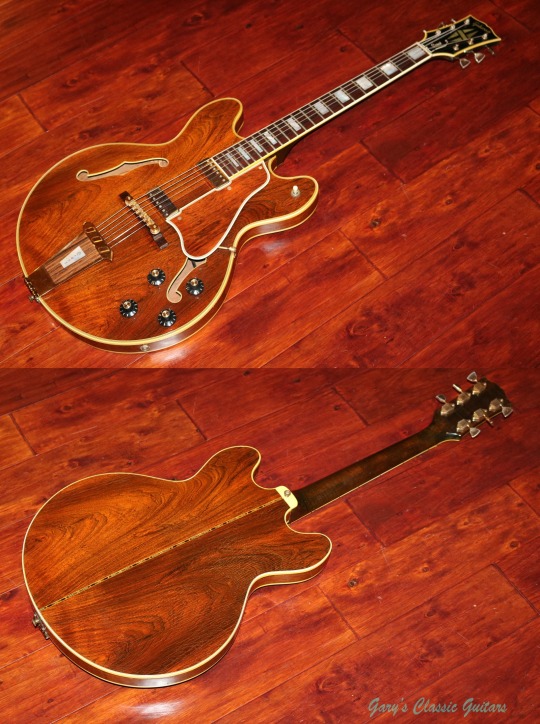
I'll be including images like these for projects that are either replicas, or I feel need the image in some way or another.
So, the rosewood veneer isn't a problem. Why is it still a shelved project, then? Well, the fact of the matter is that we live in a capitalist society. Things cost money, both for the item itself and the labour required to produce it. In short, wood is expensive, and I don't have the money yet. You may notice that "too expensive" is a running theme, even in cases where half of the expense is the guitar itself.
To avoid getting depressing, let's move on (finally)!
Tele Bass VI:
So, you may be wondering, "why's this one shelved?"
The thing is, it wasn't intentionally shelved. It's just that I can't really do anything with it without finishing the Crusader first. I need fret wire, wood for the neck, a nut, and a truss rod. Not that many things, but it's also what I need for the Crusader, and in the case of that, I at least have the wood for the neck, and a nut, but that still leaves me without a truss rod and fret wire (which I also need for my acoustic because it's got fret sprout, but that's neither here nor there).
I was intending a maple neck for it, anyway, and I need maple for the fretboard of the Crusader. Maybe I'll be able to sort that at some point. Moving on!
Lennon Les Paul Jr.:
This one's hard to call "shelved" seeing as I've done jack shit with it for 3 months at this point. Do I want to do more with it? Yes, absolutely. It's just finding the werewithall to actually go do more with it. Part of it's been the stress of organising my college stuff, but part of it's also been laziness and just not being able to decide if I want to do it or not.
I'm sure you don't want me to bore you with this one, and you saw a photo of a replica on the previous pinned post, so I'll move on.
Höfner 500/1 Violin Bass Replica:
This one is very much a doozy, but it's at least sensible.
Höfner's been going for over 100 years, that's an accepted fact, something that makes sense to everyone. Their "peak" of iconicity, however, came in the form of Sir James Paul McCartney, who has used Höfner's basses since 1961. Now, since then, they've done plenty of reissues of his (two) different basses, the 1961 with its close pickups, and the 1963 with the wide, separated pickups.
So which one would I go for? That is a good question, because it's really not what I should be asking. What I should be asking in its stead is "do I want to learn Actual Violin Lutherie to make this thing", because the whole "Violin Bass" is not just a selling point, it actually is constructed like a violin. It's a chambered hollow body, like the Country Gent, but it's the size of a violin, with the construction to match, including the use of flame maple (or, to use its more apt name, fiddleback maple) for the back and sides. The top, meanwhile, is solid carved spruce.
Don't believe me about the body size? Look at this sub-model Hofner do, based on the one you can see in Get Back:

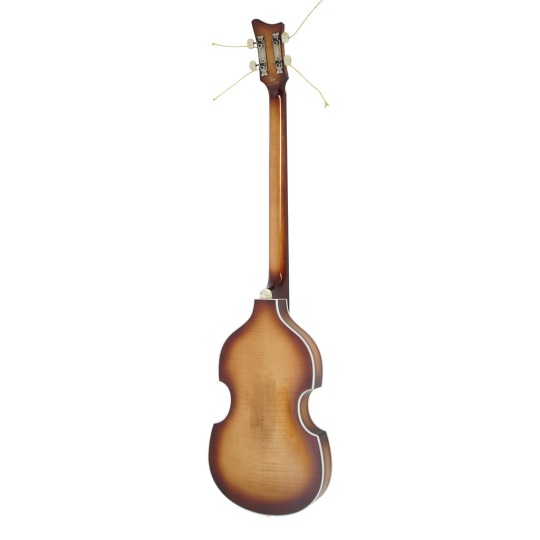
As you can see, the body is tiny in comparison to the length of the neck, especially when you compare it to an actual violin:
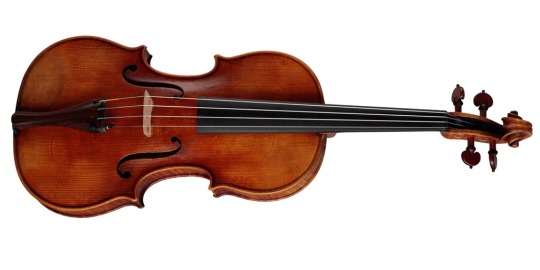
Look at the proportions on this, then look at the 500/1. Doesn't the neck seem so ridiculously long now? Anyway, that's gonna take some going at, and thus it's shelved for when I feel confident enough to actually do it, or at least to take a partial stab at it.
Now then, we've seen the ideas that I might get round to but aren't being done now for one reason or another. Let's look at the ones that won't be done at all, for one reason or another.
Lerxst 355 Replica:
To the average reader, that name's going to look like gibberish. To be honest, I don't blame you, the way it's pronounced feels like you're speaking gibberish as well. "Lurks-st". It sounds better if you try and put on a Canadian accent. Not full tilt Canadian, with all the "eh"-ing and being super polite, just a hint of Toronto.
Anyway, what's Lerxst? Or, more accurately, who is Lerxst? Lerxst is the nickname of Aleksandar Živojinović, a man known professionally as Alex Lifeson. He was the guitarist for Rush for as long as Rush had existed, until their semi-functional retirement after the death of their drummer Neil Peart. The remaining two members, that being Alex and the bassist Geddy, have performed together since, including at the Taylor Hawkins tribute concert and at the 25th anniversary concert for South Park.
Now, Lerxst has used many a guitar over the past 50 years, from that ES-335 he used in the beginning, to the large amount of PRSes he used between 1990 and 2010. His most famous, however, is the one this one is talking about: a 1977 ES-355 built by Norlin-era Gibson. It has T-Top humbuckers (named as such due to the bobbins having a slightly raised part in the shape of a T), 22 frets on a voluted neck, a 7-ply bound top (you saw me refer to this in the Crest section; 7-ply bound top doesn't mean the top is 7 plies of veneer thick, it means the binding is 7 plies thick, and is bound around a 3-ply top of maple-poplar-maple) with a 3-ply bound back, a Maestro vibrola unit, an individual set of volume and tone controls per pickup, a simple 3-way toggle, and the key part - a varitone switch, with accompanying bypass mini-toggle for the "raw" tone unmodified by the varitone.
The output jack's also mounted to the top, but considering it's an ES model, I wouldn't think that too revolutionary. So, what's a Maestro vibrola unit when it's at home? For that, we need to explain vibrato units overall.
The history starts with Clayton "Doc" Kauffman, who devised the first ever patented vibrato system in the 1930s, fittingly named the Kauffman vibrola. This worked quite differently to vibratos that we know now, as the action of changing the pitch was much more subtle, and was done through moving the arm laterally, instead of pressing the arm down to the body. The sound was meant to mimic a slide guitar (as that's where Rickenbacker's guitars originally started), but there was an ever-so tiny but incredibly crucial detail: the tuning stability was terrible. Guitarists such as John Lennon decided to replace the Kauffman units on guitars they were installed on with other models, such as the Bigsby vibrola, the second patented vibrato unit, and the first to see widespread commercial success.
The Bigsby works in a much more conventional way, using the standard we know now: push down to lower pitch, release to return to normal. Supposedly, it has terrible stability in and of itself, but that is from players who ended up being like Floyd D. Rose, who overused the vibrato of the Bigsby, requiring that they retune. The Bigsby wasn't intended for that; instead, it was only intended to provide a slight "warble" effect to playing, what some would term a "shimmering" effect.
This, in effect, is what Gibson's vibratos were meant to provide, starting in 1961 with the Sideways vibrola. I have an opinion on these: they suck, both in function and form. They copy the function of the Kauffman nearly wholesale, and the large folded up arm in direct contact with the nitrocellulose finish(!), well. Yeah, no, not for me. The Maestro, however, looks and behaves so much better. It functions like a Bigsby would, excepting that it doesn't copy the mechanism wholesale like the Sideways does with the Kauffman.
To explain this, let's go on a small side tangent about a Bigsby vs. a Maestro vibrola, because I assure you, this is actually necessary to the guitar.
The Bigsby works by loosening tension using the leverage of the tremolo arm to cause a deepening of pitch. It's kept in place and returned to normal pitch by a spring which is compressed in the action of using the vibrato unit. The Maestro, however, uses direct leverage on a bent piece of metal to cause the same loosening of tension and lowering of pitch.
This means that the Maestro, while more primitive, is easier to work with when restringing due to the fact that the strings are threaded into the tailpiece, which is then bent, changing the angle and distance between the tuners and the ball-end of the string, thus affecting the tension. The metal returning to its standard shape (because the force required to permanently change its shape has not been applied) is what returns the guitar to standard and proper tension (as long as it's been set up correctly).
The Bigsby, meanwhile, has a specific way of threading the string through the unit before sending it down the neck to the tuner and the nut. When restringing a Bigsby, there is a massive rigamarole if you don't have a Vibramate spoiler installed. You have to thread the string down from the bridge, under the tensioning bar, then up over the string bar, around it, and slot the ball-end on the tiny little post on the underside, so it can function correctly when the arm is depressed. I honestly wish I was joking about this. I have restrung a Bigsby once, and once was all the experience I needed. Never again. I heavily advocate for people to damn well use a Vibramate spoiler on their units, even if it's just because of a personal gripe.
Back to the point where we were, about... 8 or 9 paragraphs ago, the 355 generally came stock with a Maestro vibrola in 1977, so it's no surprise that Lerxst got it on his. It's even featured on the reissues from 2008:
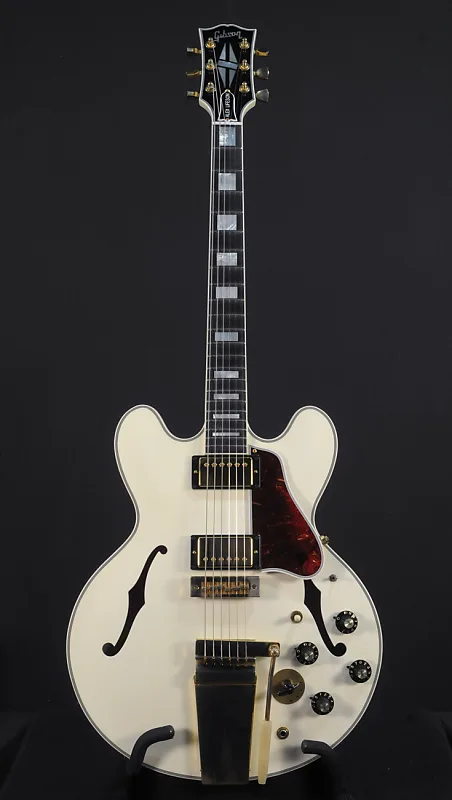
These are the same reissues that have a Fucked Up volute on the neck that's approximately halfway between the nut and the first fret, as opposed to in line with the nut. If I were to recreate this, I'd at least fix that.
So, it all seems possible, right? Then why is the build canned? Generally, it's the fact of the varitone, specifically the chokes. How, the literal fuck, do those things work. If I ever figure how they work, then maybe this will move from the can to the shelf. But right now? Canned. Completely and utterly.
Next, please!
Acoustic Rickenbacker 360/12c63:
This requires much less in the way of explaining. The Rickenbacker 360 is a famous guitar by most stretches of the imagination, soldiered on by its incarnations as the 360/12, used by George Harrison, the 370/12 used by Roger McGuinn, and the 330/12, used by innumerable amounts of famous guitarists like Peter Buck, Johnny Marr, Pete Townshend and The Edge.
But y'see, those are electric guitars. They've got magnetic pickups and all sorts of gubbins in there. My idea with this was to see if you could just... get rid of all that, construct a 360/12 in the double-bound style without that central block and all the electronics, and be left with an acoustic Ricky 12, complete with the compacted headstock and a piezo if I felt like it.
Knowing what I do about how Rickenbacker's shit is made, though, that would require making the body in the form of back, then sides, glued with bracing and then the top, with two sound holes. I'd then have to find somewhere to fit a pre-amp, and make sure that it's the usual thickness before then setting the neck in, which itself would be a 5-piece construction of maple with walnut center stripe and headstock wings, adding the truss rod(s) and the fretboard, before finally assembling the metal bits onto it.
Doesn't sound too hard, sure, but if you look at this example of what the Rickenbacker 360/12C63 looks like...
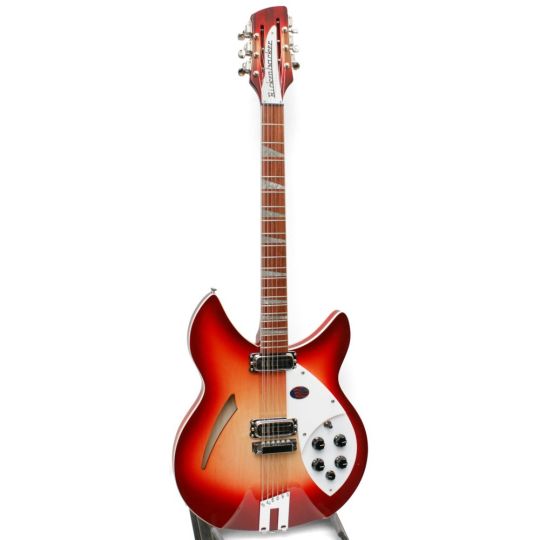
Yes, that is the entire thickness of the body. It's approximately an inch thick and not all that acoustically resonant. It'd be good as an experiment, but considering I'm debating over getting a standard acoustic 12 at some point, it's canned for that reason. Onto the last canned build, and the last build that's overall a hypothetical.
Telecaster-Shaped Red Special (TSRS):
I laid this whole thing out in a Notepad file back in May or June, as we were finishing up the Cherry XII, as a proposal of "maybe this can be the next build," but I scrapped it a month or so later because I fell into a trap I've fallen into so often it might as well be my home: I wanted to recreate a specific thing, without remembering the way that guitar is constructed, and really, what that guitar is built out of.
You see, the Red Special, built between 1963 and 1964 by Brian May and his father Harold, is a very interesting case of guitar design, in that it was designed to feedback in an appealing way. The internal cavities were actually carved out in a very specific way in order to allow for this, and most copies of the thing do the feedback, but struggle to do it exactly like his. He also has his own brand of guitars mainly made up of official replicas fitted with either a standard Strat-style trem system, that being the BMG Special, or the more accurate design mimicking the original's trem arm made of a knitting needle and a bicycle saddlebag holder.
Now, having only a Telecaster body, I couldn't recreate most of this. I mean, where am I going to put all this stuff? And the neck couldn't be slotted for 24" scale length. It just wouldn't have worked. 25", like the Harley Benton copy, maybe, but then I'd have to modify the body to allow for a 25" scale, and then rout out chambers for controls, the cavity, and the trem system's springs.
Looking back on it, I think I had a grand idea, but had bitten way too much off to just go and do it. If I ever do get it in my head to recreate the Red Special, even without a treble boost circuit or a treble boost pedal, I think I'm not going to try and start from a jump-off point, and just go at it from scratch.
Now then, we've gone through those that've been canned, let's look at the ones that aren't shelved or canned, but aren't currently in play. I denoted them as plausible above, but I might go at them at a slower rate than the Shelved builds.
Non-Specific Doubleneck:
When I say "non-specific" doubleneck, I don't mean "bland-name EDS-1275" like a Chibson or a Gear4Music or Harley Benton or anything like that.
For one, the EDS-1275 isn't the only doubleneck out there, nor is it the only doubleneck Gibson ever made. Rickenbacker made a 12/6 doubleneck 360, fittingly named the 362, as well as the 4080 doubleneck which was a bass on top and your option of a 480/6 or 480/12 on the bottom. That latter one was most famously used by Geddy Lee on Xanadu, as well as the former on A Passage to Bangkok (a song about smoking weed, if you didn't know).
Here's him with the former, in a surprising tuxedo (white with black plastics) finish:
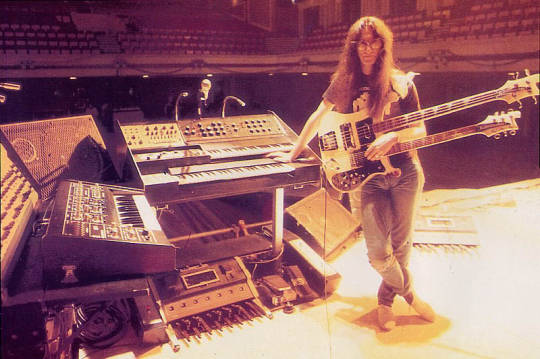
And here's him using a Fireglo 4080/12 back in 2015 for the purpose of playing Xanadu:

Anyway, that's a Rickenbacker doubleneck, but they're not the only ones to do this stuff. Fender also make doublenecks. Well, "make" is a strong term. This is the only one I know about:
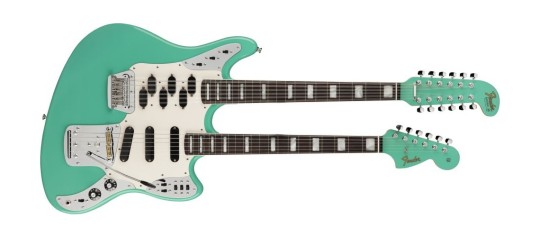
This is the craziest doubleneck I've ever seen. It's a basic 12/6, but actually No It's Not. You've got an Electric XII on top, which is the only "designed to be 12 string" guitar Fender made pre-CBS, and the Marauder on the bottom, with the vibrato merged into the pickguard, and the 5 pickup switches and the kill switch and everything that makes it the Marauder.
If I ever decide "okay, let's make a doubleneck," and then actually go through with it, I think I'm gonna take some design cues from all of these. I'll probably also chamber it so it's not uncomfortable to play for long periods of time, and just hide the chambering under the pickguards because that's a thing that could work.
Now, the other plausible idea.
Resonator Acoustic (kit build):
You know how I said kit builds were out of the question? Yeah, I didn't believe me either.
Resonators are a really cool relic of the pre-amplification era. Like, they're the step between electric guitars with magnetic pickups, and the acoustic guitars we all know, minus the piezoelectric undersaddle pickup. They work by passing the strings over a bridge mounted to a resonator cone, and when a string is plucked, strummed or otherwise makes a sound, the cone takes the vibrations and amplifies them entirely acoustically. They were originally made by a couple companies before Rickenbacker came along and invented the horseshoe pcikup and, by extension, the electric guitar.
Those companies were National String Instrument Corporation, and Dobro Manufacturing Company. The former was founded in 1927 by George Beauchamp (anyone who knows the history of Rickenbacker will know that name), and John Dopyera, a Slovak immigrant who came to America with his brothers and father in 1908, sensing that war would soon break out in Europe.
Smart move, fellas!
Anyway, Dopyera and his brothers, Rudy and Emil, soon left National to form their own comapny, Dobro. Dobro is a name with double meaning, in this case - while it's an abbreviation of Dopyera Brothers, it's also the word for "good" in a lot of Slavic languages, leading to the slogan "Dobro means good in any language!"
Due to Beauchamp's work with Rickenbacker, though, resonators fell off the radar in terms of popularity. After all, they'd figured out a form of amplification that didn't use lots of metal, so resonators ended up failing as a product. Or at least, they did for a while. Nowadays, you can find many brands producing resonators, usually for the specific tone resonators provide: rich and metallic. They're seen nowadays as bluegrass and country music instruments, but you can see people like Mark Knopfler using them for songs as well.
Now, this isn't referring to a specific kit build. I found one that's kinda an ES-style thing, with 21 frets, so that's probably the one I'd go for, not least because I like upper fret access, but it's all dependent on if I still want to build a resonator acoustic after the current build, or if I'd want to do something else entirely. It's an odd thing, my mind.
So, what now? The completed section? Eh, not exactly.
I would do a small piece on the Fretless and the Cherry XII each, I really would - God alone knows I love rambling about these builds enough, this post is testament to that on its own - but I don't need to. I made a full post about the creation of the Fretless, and made multiple posts in the course of building the Cherry XII, starting back in January and leading up to June.
But other than that? That's all there is to this post. There's nothing more I can really do in terms of explaining my ideas. I may have more ideas in between now and whenever I revisit this concept, I may reshuffle things, shelve one idea or can another. But as for everything else? It's in flux, constantly uncertain unitl we reach and observe it. I can't really say what I'll want to build after the Crusader, because I haven't finished the Crusader. Hell, I've barely started it.
Hope you enjoyed reading this. If something needs explaining further for one reason or another, tell me, and I'll try and explain it to the best of my ability.
#guitar building#lutherie#fender guitars#rickenbacker#gibson guitars#takosader's ramblings - this time into the double digits!!!#holy shit we did it#10th in the series baybeeeeeeee#anyway there's swearing in here...#somewhere i think#too many things to put in the tags so i'll hit the highlights and do the small postscripts#one - yes i'm aware that the chokes in a varitone system are capacitors and inductors#the issue's not the construction it's the values and the tones; what's the point in making a varitone if it doesn't function like it should#two - i know trogly's crest is a different variation on a normal crest#i watched his video while writing that section and clocked it because of the full hbs and the longer neck#otherwise it's exactly the same as the late '60s crest#three - if some of these feel like they came out of left field it's likely because they did#a lot of the ideas were listed on day 1 of writing this but others got added while i was writing mainly because i wanted this to be complet#comprehensiveness was another aim. yeah - as if i'll ever wring comprehensive and understandable documentation out of my head#wow this is a long post#wasn't expecting the tags to be so big either#guitar#hofner doesn't have a tag on here#but i'll put it down here for completeness
8 notes
·
View notes
Text
my old prehistory professor promised me earlier that he would soon take me on a trip to the Beskid Mountains, where he wants to fix one of sins from his youth.... but then he went silent. so i reminded him about it, and he just sent me an email that he is planning to leave on tuesday morning and that i have to decide quicklu if i want to go bc it's "high time we bough tickets and booked a place in the mountain shelter" xD we will climb the highest peak there to verify a potential archaeological site :3
i love that despite being over 70yo he still has a very youthful spirit <3 and all his plans look like this, made in the very last minute
#idk if my friends will go with us bc they currently work on a ????? uhm construction site. as ??? archaeological supervision???? no idea how#is it called in english#but they stand in front of an excavator to see if it uncovers any features and artefacts#and whenever wooden constructions appaer they have to stop the work and document these finds#so they're afraid that if they decide to go with me after they come back there will be nothing there#they reached medieval layers now#and polish law is fucked up so it gives too much power to the developers#they can fire their archaeologists without any good reasons#for example if the archaeologist decides to stop work to rescue all uncovered artefacts :)#they work for 12 h a day just to save as much as they can#bc they're local patriots and this project is very important for them#bc after it's done they will have documentation of a 700 m long profile.... the whole historical town that they love so much#they won't earn a penny lol they gave the lowest price just to get the chance to be there#either way i'm excited#it would be better to go together bc i really like them but it will be okay either way#moje
13 notes
·
View notes
Text
Me: *builds a perfectly functioning realm for the royal au from scratch* :) Ooo yippee
Also me, as I immediately sprinkle in eldritch abominations, dying/dead gods, and parasitic flora and fauna: :)
#ツ ┊ ⧼ catwalk talk ⧽ ⇹ ( ooc. )#.I am a product of my environment--#.sometimes I wish I could just rattle off about how I make worlds @ someone#.or share that experience of building it with someone#.I dunno there's always this...#.VISCERAL feeling of joy I get from it#.it's 100% enrichment for me#.watch me construct another worldbuilding Bible for Elysia like I did for my other blog#.I don't have MS word anymore but I can still make a 40 page document with a table of contents bc of libre office 😎#.I already have cataclysms in mind and honestly that's all I need
13 notes
·
View notes
Text
writing bilingual characters like "alright. so. i am 100% aware that characterization-wise and emotions-wise and narrative-wise, she'd be speaking spanish here. however. i am Also 100% aware of hOW SHIT MY SPANISH IS-"
#writing bilingual convos in the original fiction project is delightful bc it's a lazy conlang#meaning i get to study irish i get to have a whole document with phonetics n constructs and i'm never wrong#writing camila noceda on the other hand. I CANT GET HER SPANISH WRONG SHE ACTUALLY KNOOOOWSSS THAAAAT#toh#for the tags. i suppose.#once alf corrected my trc fic latin 4 me like years after i wrote it. mark of everlasting friendship there
22 notes
·
View notes
Text
hatehatehatehate writing documentation. but I think its the best way to keep everything orgenized. this is hell on earth.
#conlang#conlanging#constructed language#conlangs#ngiout#paizau#I think that in my next conlang I'll just document everything from the start#like have a skeleton document and write things up everytime I come up w/smth
4 notes
·
View notes
Text
Streamline Construction Workflow with BIM Engineers

Construction workflow is complex and demands keen attention to detail. Which is why BIM engineers help in ensuring the seamless integration and accurate workflow for other AEC professionals. Continue reading further how BIM engineers play a crucial role in AEC.
#bim modeling services#3d bim modeling#bim services#bim architectural services#bim services provider#revit families creation#point cloud to bim services#revit modeling services#construction documentation services#hire a bim specialist
2 notes
·
View notes
Text
baby i am out here hyperfixating on details you could literally never be convinced to give a shit about.
#( and having the best time in the world while i'm at it!!! )#( thank you for noticing!! i love my 18 page research documents for minuscule OC details!! )#ooc.#( i am a slave to my compulsion to worldbuild down to every bit of minutiae. )#( assume in any given thread i am mentally constructing the entire environment and trying to be consistent about playing in that space. )
4 notes
·
View notes
Text
Now, that was a problem.

"The long-forgotten roof balcony somewhere at the quietest part of the castle was the perfect place to spend some time without prying eyes. The perfect place for, say, covered rebellion meet up. But there's the nuance. It would be the perfect place, if the Titan-damned emperor's nephew didn't came to exactly the same idea about it miraculosly at the same date as them. As if he's actually suspecting something and is trying to oversee treason. But that's probably too much credit for him. He's hardly the improvising type, that obedient little prince. Still, the balcony was occupied, and maybe there were spying bugs (and possibly the snarkiest of the castle's vivarium) being planted right now, so Head Witch Darius decided to work proactively and outspy the emperor's spy first by sending through the closed doors the tiniest abomination he could manage without losing direct control over it's sight and motions. ...the Golden Guard was standing by the balcony rim and staring in the evening sky. Otherwhise than that he was doing absolutely nothing. Not that was enough for dropping vigilanse, though, even if it seemed that no spying bugs ot spells were planted yet. And indeed, a few minutes later he finally turned away from the rim. Only to sit down cross-legged on the cobbled floor, the artificial staff being placed at hand nearby. The cobbled floor in question was very dusty. Gross. Meanwhile the Guard took of his helmet, and that was slightly more gross, because the face underneath was unmistakebly beaten up. The right cheek was swollen, with black eye as the icing of the cake. Alright, it's not like he was concerned or anything, but Darius still thought that the injury was intriguing, due to it location and size. One could guess that it came somewhere from endless scout training (and any witch or demon knows that scout training sessions in the Emperor's coven are not mild at all), but even while punching your opponent in the face is not something new, it's considered weird - kind of unprofessional - to strike straight in the eye. Even then, how do you exactly punch a scout in the eye when they are masked? The mask issue remains with conjecture that the bruise was gifted from some criminal on the mission, too. So, the funny conclusion - had the Golden Guard, while unhelmeted, no less, irked someone in the castle to the state of fist-shaking rage and finally faced the consequences of his own arrogance? The beaten up in question wasn't giving any hints about personality of the one who did it, though. He just gingerly touched his cheek, and then suddenly pulled off one of his gloves and turned it inside out while reaching with the other hand for his staff. "I wonder if this counts as excessive use of magic." And here was the irony: "Well, no one will see that anyways, so..."
The Guard tightened the hand on the staff in concentration while it glowed in red, and soon it conjured small cubes of ice in the glove. As always with artificial magic, without a spell circle, or any circling motion at all.
It was honestly weird to watch. Were there any restrictions on the amount of spent spells in this thing? Probably, if there was an implication of "excessive use of magic".
…Actually this information could be quite in handy if the rebels would clash with the Emperor's right hand someday. Hopefully not. But still. Maybe this whole spying thing had a point after all, because before this moment all what Darius had got was some skygasing and then a weird black eye on weared-out teenage face, which wasn't a lot. Although he must admit, he was intrigued. This was very much not his mentor, the predecessor certainly outgamed the descendant, but it was interesting to watch the youngster in his normal behavior without the bratty antics and formal etiquet - a rare sight indeed. Besides, it wasn't difficult to keep control on one small abomination while attending the paperwork in his private quarters, so it's not like he's wasting a lot of energy.
The iced glove was pressed on the bruise for a few minutes, and, when it was probably too cold to keep, was put into crook of the shoulder inside the white cape. The Guard layed his cheekbone on top of it with an almost blissfull expression. Huh. The swelling must be pretty painfull, if such reaction. The probably dirty glove on the face was still a disgusting sight, but at least it was turned inside out, so Darius must give him at least that, if not the credit for creativity about the whole makeshifted compress thing."
#behold: the sketched piece of art and a text draft from the .odt document on my laptop#here we have: tired as F Hunter doing some woodcarving on his free time!#Darius from before “Any Sport In a Storm” episode happens being funnily paranoid on really really non important occasion!#And also doing some very good guesses about the sourse of GG's injury!#while simultaneously totally misinterpreting the whole “physically abused by his own uncle” picture!#(forgive his hostility towards hunter he did not realise his fuck up yet)#(also pls forgive me for misspellings and weird sentence constructs english is not my first language)#one of the reasons the whole fic probably won't be published#although there were some funny dialogs with two neurotic castle inhabitants pointing fingers at each other like in those spiderman memes#toh#hunter the owl house#darius deamonne#implied child abuse
18 notes
·
View notes
Text
I propose a new conspiracy theory:
Aliens built the Empire State Building
There is no evidence, I just feel like it's a building that would be funny to claim aliens built
#I think the more documentation we have on something being built the funnier it is to say it was aliens#and not like a boring the aliens were the construction crew; like ignoring the evidence and saying they did it with their space magic
2 notes
·
View notes
Text
send me your energy I really need to work on this essay but I feel like I’m getting a dial tone when I try to start
9 notes
·
View notes
Text
@pikween replied to your post “went to the front desk at the emergency room to...”:
wait what do you mean she sees auras
sssoooo. im SO sorry im going to use this to lay down all i know of my mom's "clairvoyance" stuff (because i have this thing about documenting our family) so it'll be super long. but tl;dr she sometimes sees light around people and sometimes those people die within a week of that.
this has happened like 5 times so far and she's about 50 so it's not a common occurrence at all. those 5 times, she's received news that someone in town died and my mom has said that she knew they were going to die because the last time she saw them she could see the person's aura, which she describes as a bright white light surrounding them. when i asked her to describe it she said this picture of me reminds her of those auras.
This has happened both with people she loves and with complete strangers. She says she doesn't know when it started, she thinks maybe she was able to see them when she was a child, but she didn't know what they were so she didn't pay much attention to them.
The first time she realized was when her grandmother died, my mother was in high school, the same day my mother saw her aura, she died. Then it happened with some lady she saw across the street and the next day the lady was dead and it turned out she was the mother of one of my mom's acquaintances and that's how she found out that that stranger had died.
Then it happened with a couple kids, which is extremely sad, but my mom is a teacher, she sees about 300 kids every day so to me it makes sense it would happen with kids too, even if I can't in a million years begin to imagine what she must've felt with those.
And then it happened with my dad's mom too.
My mom also has had some very detailed visions and tons of instances of "bad feelings" that materialize a day later as bad news in our lives. Though she also has this with good news and she says she's seen auras on people (including kids) that don't die the next day or week; so when it happens she tries not to immediately expect a death.
and now for the debunking asdfghjks no, i'm a hugely skeptical person but for some reason i believe her about this. however, i have to say, she does lie, constantly, like waaay more than average, for many reasons. also migraines are known to show auras, not around people but it could be that? she says she doesn't have migraines but she's known for minimizing her symptoms. and last but not least, our family is like the poster of generalized anxiety disorder all the way up to that grandma who died in the third paragraph, so we're kind of always waiting for bad stuff to happen. so, yeah, all of these might just be coincidences.
my mom also is an extremely religious catholic but she does not link religion to any of this, which i guess is why i believe her, in part. i at least believe that she's seeing what she's saying she's seeing. my sister has some stuff like the visions and feelings as well. i sometimes know big news hours before anyone tells me about it, but i choose to believe it's because i am very observant lol
anyways. if you wanna hear about one of the visions, or feelings, or the news i know hours in advance, or what my mom is like in an abandoned asylum, shoot me an ask :)
#sorry again about the poorly constructed essay on my mom's clairvoyance#but thank you so much for asking about this <3#our family stuff is deeply connected to our latine culture and that's why i want to start documenting it even if its just bare facts like#this where you can't really see it lol#family history#replies#.
3 notes
·
View notes
Text
To all the haters:
I got all the headspace lore, it’s all here baby. uwu
I’m eventually gonna make a proper timeline of it all when I have the time.
#documenting events and using my creative writing to better understand and handle my mental struggles is not a bad thing#chrome#tw syscourse#my creative writing helps me to manage my psychology and spirituality#constructing my innerworld as concretely as possible has aided it regaining memories
2 notes
·
View notes